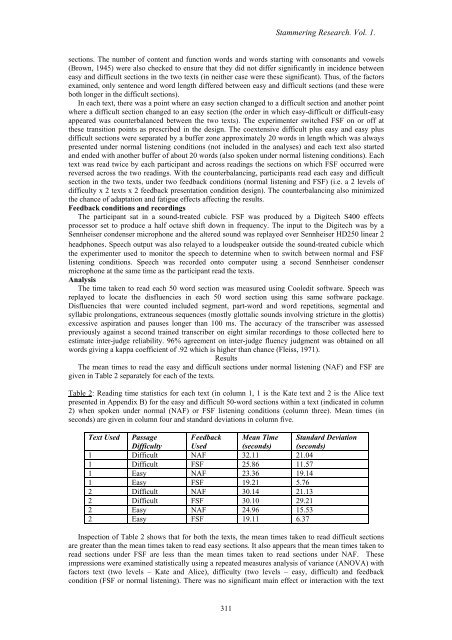Announcing 'Stammering Research' - Stammering Research - UCL
Announcing 'Stammering Research' - Stammering Research - UCL
Announcing 'Stammering Research' - Stammering Research - UCL
You also want an ePaper? Increase the reach of your titles
YUMPU automatically turns print PDFs into web optimized ePapers that Google loves.
<strong>Stammering</strong> <strong>Research</strong>. Vol. 1.<br />
sections. The number of content and function words and words starting with consonants and vowels<br />
(Brown, 1945) were also checked to ensure that they did not differ significantly in incidence between<br />
easy and difficult sections in the two texts (in neither case were these significant). Thus, of the factors<br />
examined, only sentence and word length differed between easy and difficult sections (and these were<br />
both longer in the difficult sections).<br />
In each text, there was a point where an easy section changed to a difficult section and another point<br />
where a difficult section changed to an easy section (the order in which easy-difficult or difficult-easy<br />
appeared was counterbalanced between the two texts). The experimenter switched FSF on or off at<br />
these transition points as prescribed in the design. The coextensive difficult plus easy and easy plus<br />
difficult sections were separated by a buffer zone approximately 20 words in length which was always<br />
presented under normal listening conditions (not included in the analyses) and each text also started<br />
and ended with another buffer of about 20 words (also spoken under normal listening conditions). Each<br />
text was read twice by each participant and across readings the sections on which FSF occurred were<br />
reversed across the two readings. With the counterbalancing, participants read each easy and difficult<br />
section in the two texts, under two feedback conditions (normal listening and FSF) (i.e. a 2 levels of<br />
difficulty x 2 texts x 2 feedback presentation condition design). The counterbalancing also minimized<br />
the chance of adaptation and fatigue effects affecting the results.<br />
Feedback conditions and recordings<br />
The participant sat in a sound-treated cubicle. FSF was produced by a Digitech S400 effects<br />
processor set to produce a half octave shift down in frequency. The input to the Digitech was by a<br />
Sennheiser condenser microphone and the altered sound was replayed over Sennheiser HD250 linear 2<br />
headphones. Speech output was also relayed to a loudspeaker outside the sound-treated cubicle which<br />
the experimenter used to monitor the speech to determine when to switch between normal and FSF<br />
listening conditions. Speech was recorded onto computer using a second Sennheiser condenser<br />
microphone at the same time as the participant read the texts.<br />
Analysis<br />
The time taken to read each 50 word section was measured using Cooledit software. Speech was<br />
replayed to locate the disfluencies in each 50 word section using this same software package.<br />
Disfluencies that were counted included segment, part-word and word repetitions, segmental and<br />
syllabic prolongations, extraneous sequences (mostly glottalic sounds involving stricture in the glottis)<br />
excessive aspiration and pauses longer than 100 ms. The accuracy of the transcriber was assessed<br />
previously against a second trained transcriber on eight similar recordings to those collected here to<br />
estimate inter-judge reliability. 96% agreement on inter-judge fluency judgment was obtained on all<br />
words giving a kappa coefficient of .92 which is higher than chance (Fleiss, 1971).<br />
Results<br />
The mean times to read the easy and difficult sections under normal listening (NAF) and FSF are<br />
given in Table 2 separately for each of the texts.<br />
Table 2: Reading time statistics for each text (in column 1, 1 is the Kate text and 2 is the Alice text<br />
presented in Appendix B) for the easy and difficult 50-word sections within a text (indicated in column<br />
2) when spoken under normal (NAF) or FSF listening conditions (column three). Mean times (in<br />
seconds) are given in column four and standard deviations in column five.<br />
Text Used Passage Feedback Mean Time Standard Deviation<br />
Difficulty Used (seconds) (seconds)<br />
1 Difficult NAF 32.11 21.04<br />
1 Difficult FSF 25.86 11.57<br />
1 Easy NAF 23.36 19.14<br />
1 Easy FSF 19.21 5.76<br />
2 Difficult NAF 30.14 21.13<br />
2 Difficult FSF 30.10 29.21<br />
2 Easy NAF 24.96 15.53<br />
2 Easy FSF 19.11 6.37<br />
Inspection of Table 2 shows that for both the texts, the mean times taken to read difficult sections<br />
are greater than the mean times taken to read easy sections. It also appears that the mean times taken to<br />
read sections under FSF are less than the mean times taken to read sections under NAF. These<br />
impressions were examined statistically using a repeated measures analysis of variance (ANOVA) with<br />
factors text (two levels – Kate and Alice), difficulty (two levels – easy, difficult) and feedback<br />
condition (FSF or normal listening). There was no significant main effect or interaction with the text<br />
311


